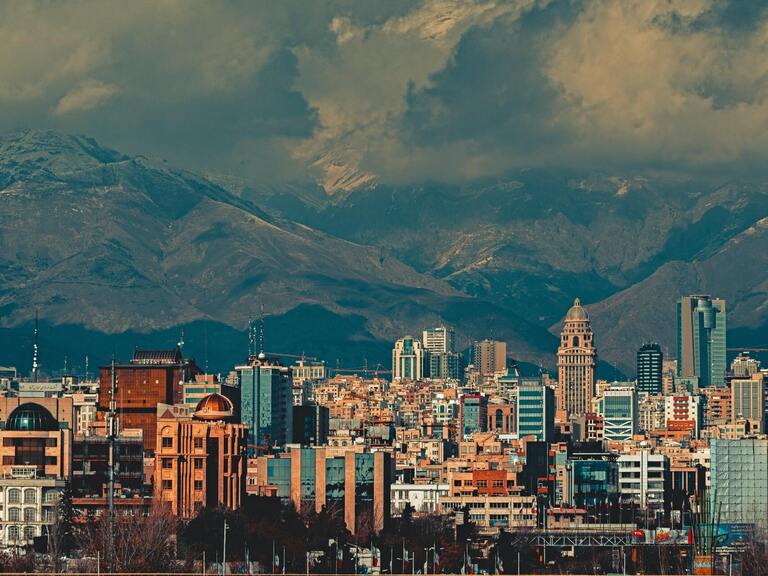An Anatomy of Turkish Foreign Policy: 1995 – 2020, Issue #4: Turkey & Iran
Introduction
This study is the fourth bilateral analysis of Turkish Foreign Policy (TFP) in the research project titled: “An Anatomy of Turkish Foreign Policy.” Our goal is to quantify TFP’s evolution between 1995 and 2020 through a data-driven account free of speculative remarks. In this analysis, we will focus on the development of Turkey’s bilateral relations with Iran. In doing so, we will begin with a quantitative analysis of the relations to provide an overview. Next, we will survey the notable events between the two countries that impacted bilateral relations.
The Data
We use data from the publicly available Lockheed Martin Advanced Technology Lab’s Integrated Crisis Early Warning System (ICEWS) event database in the present analysis. We discuss the methodology in Issue #1 of this series.[1] In brief, ICEWS features information on directed dyadic interactions between countries (i.e., Turkey-Iran), where each observation includes details of who (source) did what (action) to whom (target), when (time), and where (location). Each interaction is then assigned an intensity score that ranges between -10 and +10 based on the category of the interaction. Negative interaction intensity scores imply conflict, and positive interaction intensity scores indicate cooperation. We calculate monthly and annual averages of the intensity scores to form indices.
Turkey – Iran Relations: An Overview
How frequently does Turkey interact with Iran, and what is the nature of its interactions? In Issue #1, we demonstrate that Iran is one of the top interaction partners of Turkey. The aggregate interaction frequency suggests that the total is the fifth highest between January 1st, 1995, and April 30th, 2020. ICEWS features 11,915 observations with Iran within this timeframe, of which 3,011 are unique interactions.[2] This number corresponds to almost six percent of Turkey’s total interactions of 186,255. Table 3.1 below compares the summary statistics of Turkey’s directed dyadic interaction intensity scores with Iran and the rest of the World.

The summary statistics in Table 3.1 provides a good overview of the overall interactions’ essence. The higher average intensity score of 1.77 between Turkey and Iran compared to the 1.34 between Turkey and the World suggests that Turkey’s relations with Iran vis-à-vis the World were, on average, more cooperative. This difference can also be qualitatively captured by exploring the shapes of the distributions. Figure 3.1 and Figure 3.2 below are event intensity score distributions. In both distributions, any value to the left of 0 suggests a conflictual interaction and to the right suggests a cooperative interaction. We also include the results of a simple difference-in-means test in Table 3.2, which indicates a statistically significant difference in the average intensity of interactions towards Iran compared to the World.
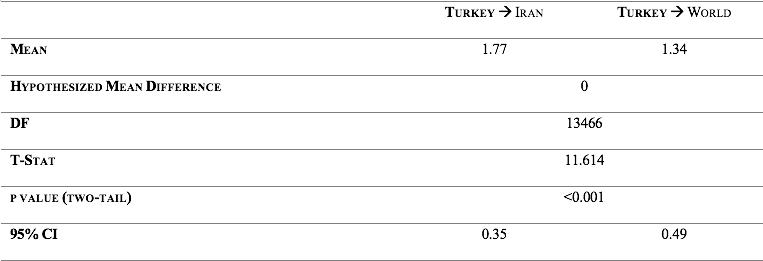
Looking at the relations between Turkey and Iran exclusively, the summary statistics from Table 3.1 suggest the instances of cooperation between the two countries were slightly more than instances of conflict, given the negative skewness in the data’s distribution.
What was the variation in the frequency of bilateral interactions over time? Figure 3.3 below demonstrates the frequency of both cooperation and conflict initiations by Turkey toward Iran by year. It should be noted that this figure does not take into account the magnitude of cooperation or conflict. The figure suggests the presence of three phases. The first phase between 1995 and 2002 is marked by low interaction initiation. The second phase, which spans 2002 and 2019, features an increasing frequency of cooperative interaction initiations. During this time, the frequency of conflict initiation remains steady and low. The year 2019 marks the third phase, defined by a reversal of the two trends; for the first time since 1995, instances of conflict initiation became higher than instances of cooperation.


The disaggregation of interaction frequency by intensity over time provides further information. Figure 3.4 demonstrates the annual distributions of interactions. The distribution at the bottom displays the values for 1995 and the one at the top for 2020. As always, while 0 marks neutral events, any interactions that are located to the right of 0 are classified as instances of cooperation, and to the left are instances of conflict. The magnitude of interaction intensity increases as it approaches the minimum and maximum values (10 and -10). The figure remains steady overall, with slight rightward changes in the low to mid-intensity cooperation initiations. The two years that have discernable spikes in the left tails, capturing significant conflict initiation, are 1999 and 2019. Figure 3.5 demonstrates the variation in relations during a given government.[3] The intensity and frequency of interactions with Iran are at their highest during the 59th, 60th,61st, and 66th governments. We also observe an abrupt deterioration in interactions during the 66th Government’s rule, during which Operation Peace Spring was conducted.
States actively react to signals that they receive from their counterparts and adjust their foreign policy towards them. An index can be particularly useful for understanding the overall evolution of the signals in bilateral relations. Our most noteworthy contribution in this report is the index of bilateral relations between Turkey and Iran. We present the index in In Figure 3.6.
To draw our overall dyadic relations index, we begin with calculating a simple monthly intensity average of all interactions for a given month. The values of these averages are displayed with the black dots in Figure 3.6. A dot above zero suggests that the interactions for the month were cooperative, and a dot below suggests otherwise. Next, we move on to the trendlines. An upward-pointing trendline suggests an improvement in the bilateral relations and an increase in cooperation, whereas a downward-pointing trendline suggests growing discord, regardless of its color. We first focus on the short-term trends and calculate a six-month moving average. This line shows the average intensity scores considering the preceding six months and is displayed with the red line in Figure 3.6. This trendline describes the short-term cascades in which the two countries interact with each other. Finally, we turn to the long-term and fit a non-parametric locally weighted smoothing line among all the monthly averages, which is displayed with the blue line in Figure 3.6. The grey band around the blue line shows the 95% confidence intervals. This line captures the trend in the long-term evolution of bilateral relations between Turkey and Iran. The line suggests an overall gradual improvement in the relations until 2019 during which the line’s incline stalled and likely started to reverse.
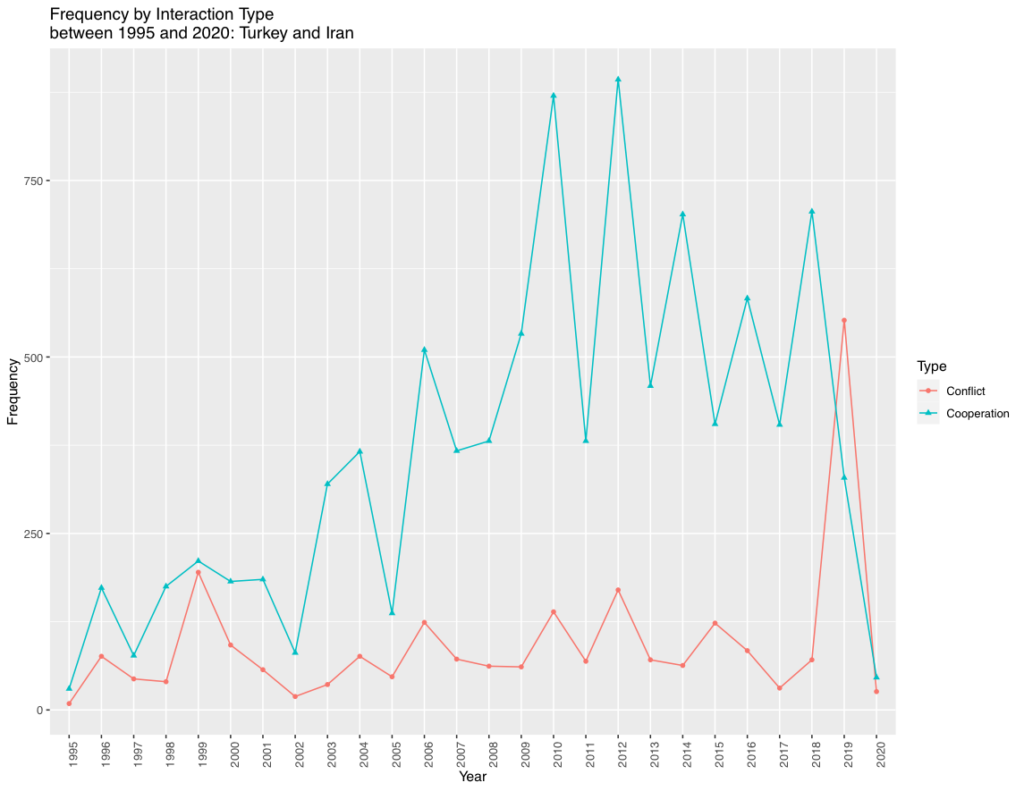
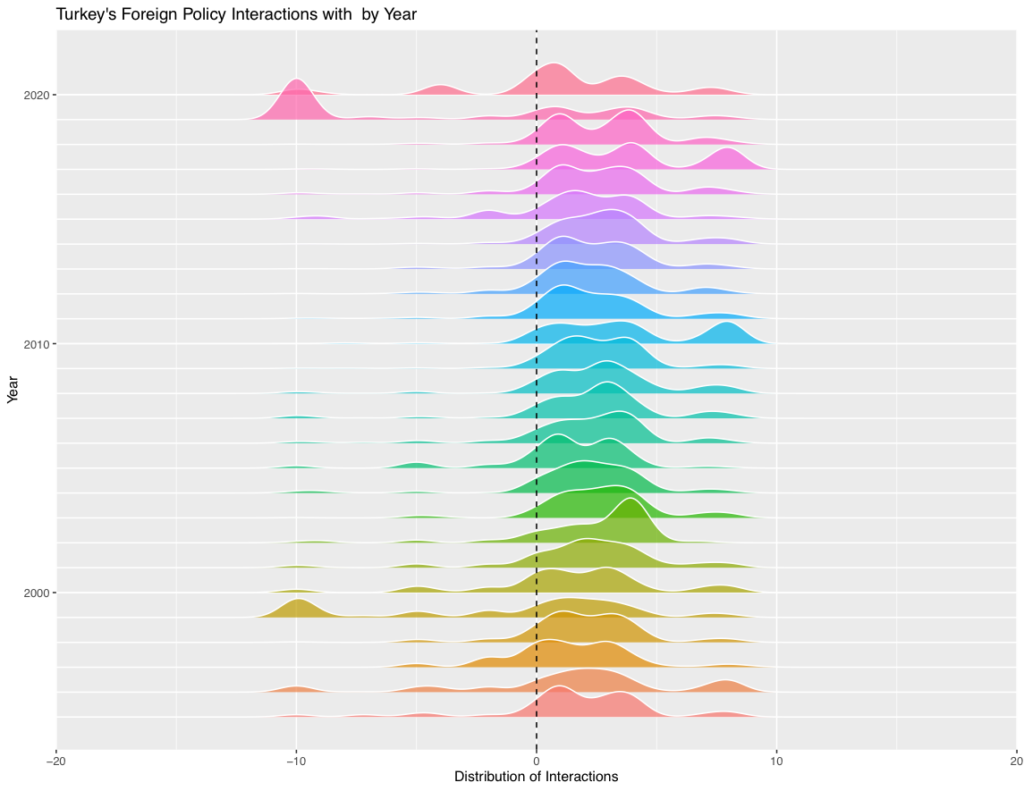
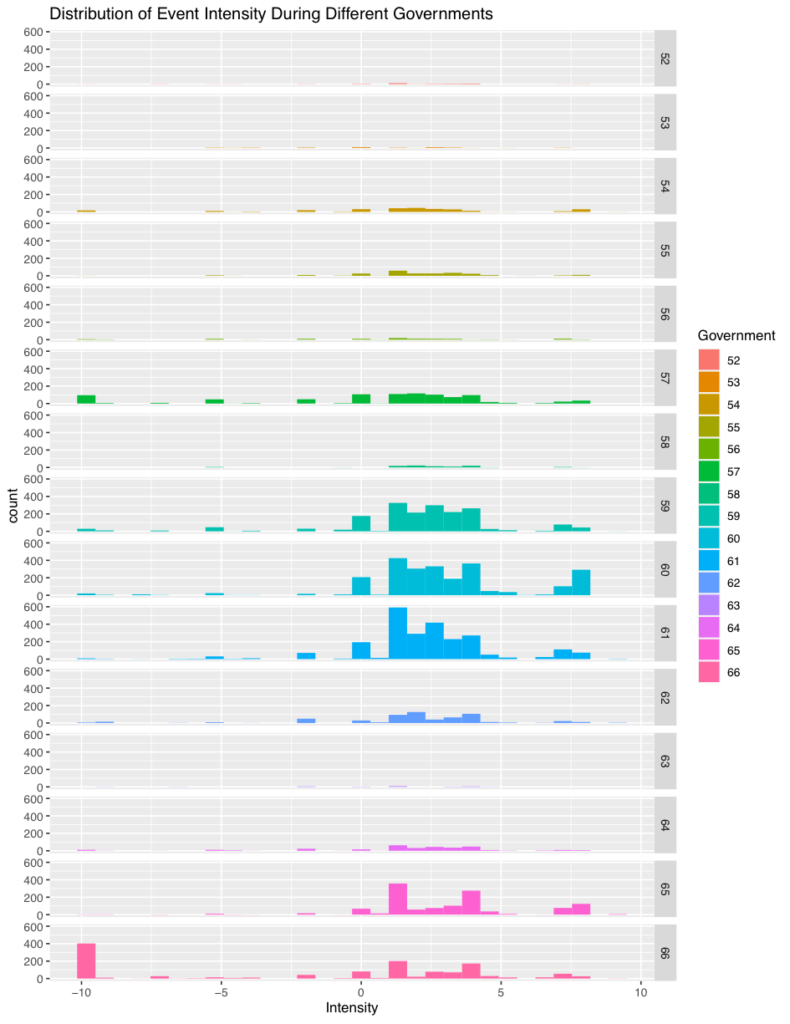
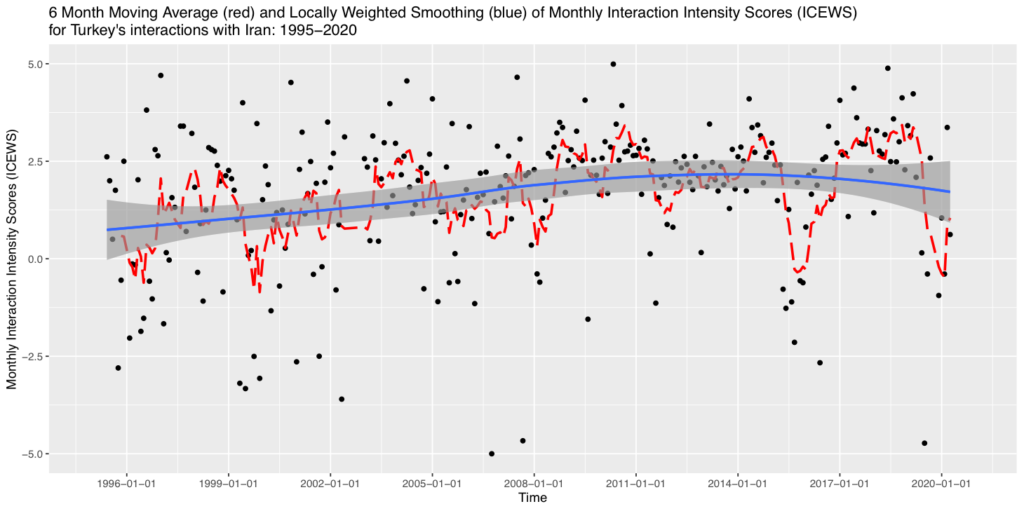
Defining Moments in Turkey – Iran Relations
What are the momentous events that defined the relations between Turkey and Iran? In this section, we focus on the milestones that defined the bilateral relations within the past two and a half decades between the two countries. We use the ICEWS intensity variable for filtering individual milestone interactions.
Iran Gas Deal with Turkey, 8 August 1996
The Refah Yol Government, under the authority of Prime Minister Necmettin Erbakan, signed a gas purchase agreement of 10 billion cubic meters per year from Iran. Erbakan met with the religious leader Ayatollah Ali Khamenei during his visit to Iran in the same month. Turkey also decided to buy four million tons of oil from Iran. [Source]
Jerusalem Night in Sincan, 31 December 1996
Local Municipality Sincan Mayor Bekir Yıldız organized the events known as Jerusalem Night as part of municipal activities with the participation of Iranian Ambassador Ali Rıza Bagheri. Following the events, General Cevik Bir expressed his view of Iran as an Islamic regime exporter and Iran should be considered a “terrorist state.” Iran protested Bir’s statements and withdrew its diplomatic envoy from Ankara. [Source]
Airspace Violation Allegation, 20 July 1999
Iran alleged that Turkish Air Forces violated Iranian airspace while conducting an air operation against the terrorist organization PKK. Turkey suggested that the two countries’ high-level civil and military bureaucrats bilaterally investigate the allegations. [Source]
Trans – Turkish Pipeline Agreement, 18 November 1999
Turkey signed the Trans-Turkish pipeline deal which stands as an alternative to the the Russian and Iranian routes for transporting natural gas resources of the Caspian Sea to international markets. [Source]
Establishment of Turkey-Iran Business Council, 6 November 2001
President Ahmet Necdet Sezer hosted Iranian Foreign Minister Kemal Harrazi in Ankara. Sezer announced that the Turkey-Iran Business Council established to improve the bilateral economic ties at the private sector level. This meeting was followed by a subsequent business council meeting in December 2001. [Source]
Iranian Gas Becomes Operational in Turkey, 10 December 2001
Iran gas deal signed in 1996 became operational in Turkey in December 2001.
[SOURCE]: Retired Senior Energy Bureaucrat of Turkey
Turkey-Iranian Business Council Meeting in Tebriz, 18 June 2002
Iran’s President Muhammed Hatemi accepted the invitation of the Turkey-Iranian Business Council Meeting, which perceived as a strong message by President Ahmet Necdet Sezer to strengthen cooperation at the business level. Heads of the two states were also present in the meeting. In line with this, Sezer said, “we are here together with Mr. Khatami is an indication of the importance of the role of the private sector in the development of economic and commercial relations.” [Source]
Visit of First Vice President Reza Aref to Turkish Presidency, 23 April 2003
President Ahmet Necdet Sezer hosted the First Vice President of Iran, Reza Aref. Foreign Minister and Deputy Prime Minister Abdullah Gul and State Minister Ali Babacan were also at the reception. Iranian First Vice President Aref stated that President Sezer’s visit to Iran in June 2002 marked a turning point in the relations between the two countries. [Source]
Ahmet Necdet Sezer’s Participation to Organization of Islamic Conference, 17 October 2003
President Ahmet Necdet Sezer participated in the 10th Organization of Islamic Conference (OIC). Sezer evaluated that bilateral relations were on a good track. Sezer also renewed his invitation to President Khatami to Ankara. [Source]
Turkey-Iran Joint Economic Commission Meeting, December 2004/January 2005
In the 18th Term Meeting of the Turkey-Iran Joint Economic Commission, State Minister Kursad Tuzmen chaired the delegation of the Republic of Turkey, and Ahmad Khorram while the Minister of Transportation chaired the delegation of the Islamic Republic of Iran. In the meeting, the parties decided to establish Commerce, Banking and Industry, Transport, Communication and Customs Affairs, Coordination and Monitoring Committees. [Source]
Memorandum of Understanding Over Transportation of 30 Billion Cubic Meters, 13 July 2007
Turkey and Iran agreed on a Memorandum of Understanding to transport 30 billion cubic meters of Iranian and Turkmen natural gas to Europe. The United States criticized the agreement due to the deepening ties between Turkey and Iran on energy cooperation. Additionally, the deal included granting licenses to state-owned Turkish Petroleum Company Corporation (TPAO) to improve three sections of Iran’s South Pars gas field. [Source]
Turkey and Iran Agreed to Build 10,000-MW Hydro Project, 21 August 2007
Turkish Energy Minister Hilmi Guler announced that Turkey and Iran agreed to a series of energy agreements related to the joint construction of a 10,000-MW hydroelectric project. In addition, the parties agreed on three natural gas power plants totaling 6,000 MW. They signed another contract for Turkey to import between 3 billion and 6 billion kilowatt-hours of electricity annually from Iran. [Source]
Erdogan Met with Ahmedinejad, September 2007
President Recep Tayyip Erdogan met with Iran’s President Mahmoud Ahmedinejad to discuss energy deals, while Turkish Foreign Minister Ali Babacan met with his U.S. counterpart Condoleezza Rice. United States brought on the agenda of possible U.S. sanctions on Iran’s energy deals in the region at the United Nations General Assembly. Simultaneously, BOTAS Chief Executive implied the partnership of BOTAS in the international pipeline project Nabucco which needs Iran’s gas to fill the pipeline, whose capacity is expected to reach 31 billion cubic meters by 2020. [Source]
Turkey Becomes the First Strategic Partner of the GCC, 3 September 2007
Turkey became the first country to be given the status of strategic partner of the Gulf Cooperation Council outside the Gulf. Foreign Minister Babacan expressed his intention to sign a free trade agreement with the GCC as soon as possible. In the same meeting, Qatari Premier said that Qatar “would be able to sign a similar memo of understanding with Iran.” [Source]
Turkey-Iran Signed a Memorandum of Understanding over Security Issues, 17 April 2008
After the 12th High-Security Commission Meeting between Turkey and Iran, a memorandum of understanding was signed between the two countries to fight crime and criminals, particularly focusing on terrorism. [Source]
Turkey and Iran Shares Intelligence, 5 June 2008
Turkish Land Forces General Ilker Basbug announced that Turkey and Iran were sharing intelligence against the terrorist organization PKK. [Source]
Turkey Opposes Iran’s Nuclear Weapons, 16 August 2008
In one of his first interviews as President of Turkey, Abdullah Gul stated that Turkey does not accept the development of mass destruction in the Middle East. [Source]
Turkey and Iran’s Natural Gas Memorandum of Understanding, 17 November 2008
According to the memorandum of understanding, Turkey would acquire the right to operate the 22nd, 23rd and 24th natural gas phases in the South Pars basin and build a pipeline. The pipeline was also planned to transport the natural gas to Turkey. The plan was to transfer the resources of Iran and Turkmenistan to Turkey and Europe via Iran. According to the Iranian Sources, It is expected that approximately 35 billion cubic meters of natural gas will be transferred annually. The agreement was not implemented. [Source]
Former Prime Minister Erbakan met with Iranian President Ahmadinejad, 19 April 2009
Former Prime Minister Necmettin Erbakan met separately with Chairman of the Assembly of Experts and the Council of Diagnosis of the Benefit of the Order, Ayatollah Ali Ekber Hashemi Rafsanjani, former President Muhammed Hatemi, Foreign Minister Menucehr Mutteki, Parliament Speaker Ali Larijani, and Judiciary Chairman Ayatollah Mahmud Hashemi Shahrudi. During the meetings, views were exchanged on Turkey-Iran relations and regional and international developments. [Source]
Iran Signs a Nuclear Deal with Turkey and Brazil, 17 May 2010
After negotiations between the leaders of Iran, Turkey and Brazil, the parties reached an agreement to enrich their uranium at abroad. The Iranian Ministry of Foreign Affairs announced that 1200 kg of low-enriched uranium would be sent to Turkey in exchange for nuclear fuel which could be used in research reactors. [Source]
Turkey and Iran Establishes the High-Level Cooperation Council, January 2014
Foreign Minister Davutoglu invited the Minister of Foreign Affairs of Iran, Mohammad Javad Zarif, to discuss different aspects of Turkish-Iranian bilateral relations. Parties agreed to establish a High-Level Cooperation Council. Davutoglu indicated that Turkey welcomes the agreement reached between Iran and P5+1 regarding its nuclear program of Iran. [Source]
Third Trilateral Meeting of the Ministers of Foreign Affairs of Azerbaijan, Iran and Turkey, 14 March 2014
Minister of Foreign Affairs Ahmet Davutoglu invited Elmar Mammadyarov, the Minister of Foreign Affairs of Azerbaijan, and Mohammad Javad Zarif, the Minister of Foreign Affairs of Iran, to exchange views on the possibility of developing regional cooperation on issues of common interest. [Source]
First Meeting of Turkey-Iran High-Level Cooperation Council, 14 June 2014
Counterparts agreed to strengthen their relations further based on international law and good neighborly relations and in areas of mutual interest and trade relations. [Source]
Zarif’s Unofficial Visit to Turkey, 28 September 2016
Iranian Foreign Minister Zarif met with Prime Minister Binali Yıldırım and Foreign Minister Mevlut Cavusoglu. According to diplomatic sources, Zarif paid an unofficial visit to Turkey on his return to Iran from abroad. According to the Prime Ministerial sources, sides aimed for deeper cooperation in energy, bilateral trade, transportation and transportation. [Source]
The Astana Process, 23 January 2017
Representatives from Turkey, Russia, and Iran met in Astana regarding the Syria conflict. They decided to act together to strengthen the political process rather than military interventions to provide solutions in the region. [source]
Construction of 144 KM Wall Along the Turkey-Iran Border, 15 May 2017
The Head of Turkey’s Public Housing Authority announced that the Construction of a 144km wall along the Turkey-Iran border would be complete by October 2017 to impede terrorist organization PKK movements’ along the border. “The wall will be in Turkish territory. We welcome any move that increases the security and stability of the border,” a spokesperson of Iran’s Foreign Ministry said. [Source]
Zarif and Cavusoglu Meeting for Syria and Qatar, 7 June 2017
Iranian Foreign Minister Javad Zarif and Foreign Minister Mevlut Cavusoglu discussed the bilateral and regional issues, focusing on Syria and GCC countries’ Qatar Policies. Zarif stated that during the tensions between Gulf countries and Qatar, it is necessary to exchange views with Turkey. [Source]
Discussions over De-Escalation Zones, 4-5 July 2017
In the fifth meeting of Astana meetings, Turkey, Russia and Iran delegations decided to establish a Joint Working Group to discuss the details of the “de-escalation zones” in Idlib region and its periphery. [Source]
Chief of General Staffs Meet in Ankara, 16 August 2017
For the first time, Chief of General Staff of Iran Muhammed Bakiri visited Chief of General Staff Hulusi Akar as an official visit. Bakiri then met with President Recep Tayyip Erdogan. At the meetings, Turkey and Iran discussed the importance of regional cooperation against terrorist organizations and the necessity of existing collaboration on the borders. [Source]
Sochi Summit with Erdogan, Rouhani and Putin, 22 November 2017
Leaders announced their expectations regarding the future of Syria at the joint press conference after the Sochi Summit’s conclusion remarks. President Recep Tayyip Erdogan said the priority is “the exclusion of terrorist groups from the process.” President Erdogan added that Turkey agreed with Rouhani on improving countries’ bilateral ties. [Source]
Erdogan Criticizes the US’s Decision to Withdraw from the Iran Nuke Deal, 14 May 2018
Erdogan said he did not find the US administration’s decision to withdraw from the deal correctly. “Continuity between states is fundamental, especially the agreements are the assurance of the international continuity,” he said. [Source]
Guarantors of the Astana Process, 13 June 2018
Officials from Turkey, Iran, and Russia met with the United Nations (UN) to form a constitutional committee for Syria in Geneva. Previously, the same countries discussed within the highest level for forming a political resolution for Syria as the guarantor countries for the Astana process. [Source]
The Tehran Summit, 7 September 2018
The presidents of Turkey, Russia, and Iran met at the Tehran Summit to find a political resolution for Syria even though they disagreed on the ceasefire decision. The statement signed by the leaders declared further cooperation in the Syria conflict in line with the Astana Process. [Source]
Zarif’s interview on State Television, 26 August 2018
Iran’s Foreign Minister Zarif stated that “Turkey is a leading country among those we have good relations with.” Zarif made that statement while there were ongoing political tensions between Ankara and Washington due to the arrest of American citizen pastor Brunson. [Source]
Zarif’s Unexpected Visit to Turkey 29 August 2018
Iranian Foreign Minister Mohammad Javad Zarif met with Turkish President Recep Tayyip Erdogan to discuss the developments in the Idlib region, where Ankara worries about possible new migration waves from Syria to Turkey. [Source]
Turkey Benefits from the US Waivers, 8 January 2019
The United States had granted Turkey import waivers from Iran in early November. In December, Turkey took delivery of two tankers carrying Iranian crude oil, equivalent to about 54,000 barrels per day. Turkey indicated that the waiver enables third-party countries to take 3 million tons a year, equivalent to about 60,000 barrels per day. [Source]
Fourth Sochi Summit Backed Syria’s Territorial Integrity, 14 February 2019
Turkish President Recep Tayyip Erdogan, his counterparts Vladimir Putin Hassan Rouhani met in Sochi for the fourth time to discuss the ongoing developments in Syria. Parties renewed their support for the political process. “The presidents expressed their determination to stand against separatist agendas aimed at undermining the sovereignty and territorial integrity of Syria as well as the national security of neighboring countries,” noted a statement published after the release of the trilateral summit on Syria. [Source]
On Joint Anti-Terror Operation Discussion, 20 March 2019
Turkey’s Vice Minister Muhterem Ince and Iranian counterpart Hussein Zulfiqari discussed an agreement on launching an operation against terrorist groups that threaten the security of both countries. [Source]
Turkey Stops Purchasing Iranian Oil, 23 May 2019
Turkey was one of the eight countries getting an exception from US sanctions related to Turkey’s purchase of Iran oil. As of May 2019, Turkey stopped purchasing Iranian Oil in line with the US sanction policies. [Source]
Operation Claw-2, 13 July 2019
Turkish Armed Forces launched a new operation in Northern Iraq titled Operation Claw-2. Ministry of Defense stated that “Claw-2 aims the destruction of caves and shelters used by the terrorist organization in the Hakurk region” and that “the neutralization of terrorists will continue.” Experts commented that Claw-2 Operation could suppress the Patriotic Union of Kurdistan’s influence in the operation region, which has positive informal links with the Iran regime. [Source]
Operation Peace Spring, October/November 2019
The Turkish Armed Forces conducted a cross-border operation named Operation Peace Spring into Northern Syria against Syrian Democratic Forces and the Syrian Army. Iranian Foreign Minister Mohammad Javad Zarif called on Ankara to have “respect for Syria’s territorial integrity and national sovereignty.” [Source]
[iheu_ultimate_oxi id=”21″]
[1] Lautenschlager, Jennifer, Steve Shellman, and Michael Ward. 2015. “ICEWS Event Aggregations.” Harvard Dataverse V3.
[2] Notable events are captured by multiple news agencies leading to repetitions in the dataset.
[3] There are fifteen governments in our timeframe. The terms of these governments are as follows: the 52th Government of Turkey, October 30th, 1995, to March 6th, 1996; the 53th Government of Turkey, March 6th, 1996, to June 28th, 1996; the 54th Government of Turkey, June 28th, 1996, to June 30th, 1997; the 55th Government of Turkey, June 30th, 1997, to January 11th, 1999; the 56th Government of Turkey, January 11th, 1999, to May 28th, 1999; the 57th Government of Turkey, May 28th, 1999, to November 18th, 2002; the 58th Government of Turkey, November 19th, 2002, to March 12th, 2003; the 59th Government of Turkey, March 14th, 2003, to August 29th, 2007; the 60th Government of Turkey, August 29th, 2007, to July 6th, 2011; the 61th Government of Turkey, July 6th, 2011, to August 29th, 2014; the 62th Government of Turkey, August 29th, 2014, to August 28th, 2015; the 63th Government of Turkey, August 28th, 2015, to November 24th, 2015; the 64th Government of Turkey, November 24th, 2015, to May 24th, 2016; the 65th Government of Turkey, May 24th, 2016, to July 9th, 2018; the 66th Government of Turkey, July 10th, 2018 which is ongoing. We include the data for the 51st Government as part of the 52nd Government given its short term.
- This article has been published in cooperation with Friedrich Naumann Foundation.
Fotoğraf: Sajad Nori

